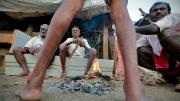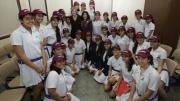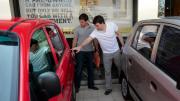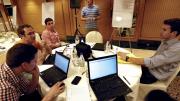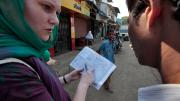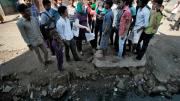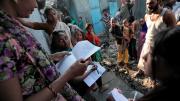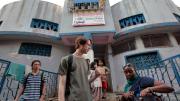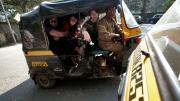At 8 in the morning, the sidewalks of Mumbai’s Nariman Point neighborhood are thick with pedestrians, getting in a morning run or stroll with a view of the Arabian Sea before starting their workday.
About a mile away, in the Machhimar Nagar (fishing village), the day’s work is already ending. Two small children with their mother scan the water for their father’s boat; fishermen who have already returned huddle around an open fire, cooking lunch, following the centuries-old way of their families.
These two neighborhoods tell the story of South Mumbai. Surrounded on three sides by water, the city’s main business district is reachable by car only from the north. Those who work here commonly commute two hours each way; those who can afford to live here now occupy one of the city’s most exclusive residential areas. Still, the fishing village and several slums have not made way for more skyscrapers. Old and new have existed in an uneasy balance for decades, and now many of these areas are so controversial—for reasons political, cultural, or environmental—that no one dares propose new development.
This silence has long fascinated professor of urban design and planning Rahul Mehrotra, a Mumbai native. Last March, he took a group of 40—Graduate School of Design (GSD) students, business and government graduate students, midcareer Loeb Fellows at the GSD—to his hometown for a weeklong design studio, the centerpiece of a semester-long studio course.
The students focused on the Backbay Reclamation, an area that includes both Nariman Point and the Machhimar Nagar. These neighborhoods and surrounding areas were built on backfilled land in a project that began in the 1930s, but was halted in the 1970s due to corruption and flagrant violations of the original land-use plan. Today, the map of South Mumbai shows a gap in the western side of the shoreline, as if the city is missing two teeth. These are the two sectors of the project that were never completed.
The Harvard group’s conclusions—a grab bag of ideas covering landscape, transportation, infrastructure, and environmental issues, including proposals for creating more space through landfills and for making better use of existing space—have become a book, which was to be presented at a symposium in Mumbai in February, during a visit by Mehrotra and the students of this year’s studio course (focused on a different area, the eastern port lands of Mumbai). The students hope that, because they are not affiliated with any corporation or with the government, their recommendations will be perceived as neutral, and might help the Backbay area lose its status as a conversational third rail. With any luck, says Zhuorui Ouyang, a GSD master’s candidate from last year’s group who is focusing on Mumbai in her thesis, “our presence opens up the conversation.”
Harvard emissaries were opening many conversations across India in January. Students came for between-semesters academic projects. Professors visited to check in on research, NGOs they have started, and companies they advise. And President Drew Faust made her first visit, with stops in Mumbai and Delhi.
India’s recent rapid economic growth, and resulting social changes, have made for fertile scholarly ground. Business students can study some of the many innovative companies being launched. Public-health students take on the challenge of improving conditions for people migrating in massive numbers to urban slums, and for those still living in desperately poor rural areas.
In the past several years, the University’s involvement in India “has come to some maturity,” says Rothenberg professor of the humanities Homi Bhabha, a Mumbai native who directs the Mahindra Humanities Center (funded by a gift from Anand Mahindra ’77, M.B.A. ’81, a senior executive at the Indian conglomerate Mahindra Group).
Faust, in explaining the significance of her visit to India, noted the widening scope of activities in the country, and across South Asia. Tarun Khanna, Lemann professor at Harvard Business School (HBS), concurs: “We have extraordinarily greater reach in the region now,” compared to a few years ago. Khanna just finished his first year as director of the University’s nine-year-old, interdisciplinary South Asia Initiative (SAI), which last year supported research by 24 undergraduates, 28 graduate students, and two professors; last spring, a symposium in Cambridge on the future of South Asia drew 200 people. But “more than the numbers,” says Khanna, “I think it’s the diversity of the people who have come together” that gives the initiative its richness.
The University has historically focused more on East Asia, a fact Khanna attributes in part to India being part of “the British embrace,” with weaker ties to the United States. (That hasn’t stopped other U.S. schools: Yale president Richard Levin, for instance, has traveled to India four times since 2005, and plans annual visits.) But as the United States has received more South Asian immigrants, and as their children become curious about their roots, demand has risen for courses on the region. At the same time, India’s booming economy has created jobs for recent graduates like the two now spearheading the growth of an alumni club in Mumbai: Russell Mason ’10, who works on low-income housing for a real-estate division of the Mahindra Group, and Gaargi Ramakrishnan, M.S. ’10, co-founder of EkSMS.com, a website and text-messaging service focused on Mumbai dining and nightlife. (HBS has long had an active alumni group in the city, and an alumni club in Delhi has a long history, but the Mumbai club was incorporated only last November. President Faust’s reception, which drew 160 registrants, was its second official event.)
Faust is the fourth sitting president to visit India, where Lawrence H. Summers went in 2006, Derek Bok in 1987, and Nathan Marsh Pusey in 1961. She emphasized the importance of liberal-arts education in a speech at the University of Mumbai (see “Faust Receives Indian Welcome”) and at a SAI-sponsored symposium in Delhi on higher education in South Asia. (For his part, University of Mumbai vice chancellor Rajan Welukar called the occasion of Faust’s visit “the happiest day in the history” of that institution.) The president also toured the office SAI shares with the HBS India Research Center, established in 2006; visited a high school for girls; and met with Prime Minister Manmohan Singh, with whom, she said, she also underscored the importance of access to higher education.
Some harvard-india connections go way back. Barry Bloom, Distinguished Service Professor and Jacobson professor of public health, first traveled there in 1970 to conduct research on leprosy and teach the first course on immunology in the country. That experience kindled an interest in global health that led to 30 years of work for the World Health Organization. When Bloom became dean of Harvard School of Public Health (HSPH) in 1998, he desired to give back to the country that had so influenced his career. He has spent the years since working with the Indian government and philanthropists to open a set of four schools of public health there through the Public Health Foundation of India. (Its president, K. Srinath Reddy, currently has a visiting professorship at HSPH.)
Recent donations from Indian citizens have created other lasting links. There is the Murty Classical Library of India book series (which will complement the Loeb Classical Library, I Tatti Renaissance Library, and Dumbarton Oaks Medieval Library); the Mahindra Humanities Center; and HBS’s Tata Hall (funded by the charitable arm of the Tata Group, famous internationally for the cheap and tiny Tata Nano automobile).
Meanwhile, professors from business fields to the humanities say they have noticed increasing student interest in courses about India. Faust mentioned three general-education offerings by name in her University of Mumbai speech: the modern history of South Asia, taught by Lamont University Professor and Nobel laureate Amartya Sen and Gardiner professor of oceanic history Sugata Bose (SAI’s first director); “Love in a Dead Language,” in which professor of religion and Indian philosophy Parimal Patil, chair of the department of South Asian studies, introduces students to classical Sanskrit work; and “Contemporary South Asia: A Survey of Intractable Problems and Innovative Solutions,” in which Khanna presents companies, nongovernmental organizations (NGOs), and public initiatives that have solved lingering problems in education, health, telecommunications, and finance.
One of the companies students consider is Aspiring Minds, a startup based outside Delhi whose founders Khanna has advised since one of them (then a graduate student at MIT) approached him after a lecture in Cambridge. (Khanna was also a founding investor.) With its proprietary, computer-adaptive standardized tests, the company aims to help employers more easily find employees who are good matches—sorely needed, given that in the IT field alone, India’s top three companies annually hire between 10,000 and 30,000 engineers each. The company has grown fast: it now tests 25 percent of India’s new graduates in engineering, the field it entered first. And there is plenty of room to grow further: the Indian government has set a goal of doubling the proportion of youths who attend college by 2030.
The students learn as well about PRS Legislative Research, a Delhi-based nonprofit founded by C.V. Madhukar, M.P.A. ’04. (Khanna has an advisory role.) The organization—aware that India’s members of parliament lack a publicly funded research staff, and cognizant of the risks when legislators vote on issues they know little about, or get information from those with vested interests—sends each of India’s 790 MPs a brief analysis of every bill before them each session. (This is only a few dozen bills per year.) The group treasures its reputation as strictly nonpartisan; in India’s divisive political climate, Madhukar is heartened that members of the two largest political groups, the Congress and Bharatiya Janata parties, contact PRS in numbers proportional to their seats in Parliament.
The superhumanly busy Khanna also advises mDhil (founded by Nandu Madhava, M.B.A. ’06), a mobile-health-technology company based in Bangalore, and Chai Point (founded by Amuleek Singh Bijral, M.B.A. ’06), which operates more than a dozen small shops where even low-paid workers can escape the hustle and bustle of Bangalore’s streets and enjoy a cup of tea in peace.
Khanna’s portfolio mirrors a larger trend: Harvard-India links, largely focused on business and Mumbai, are diversifying in terms of geography and subject matter—and University scholars are making a mark on the country from the highest reaches of government down to the grass roots.
Undergraduates arrive in Bangalore each summer to work in life-sciences labs, in a program led by professor of molecular and cellular biology Venkatesh Murthy. Sen and Bose participate in an advisory group to guide their alma mater, Kolkata’s Presidency College (a prestigious institution that dates from 1817) as it makes the transition to a full-service, English-language, liberal-arts institution. Atul Gawande, associate professor of surgery at Harvard Medical School and associate professor in the department of health policy and management at HSPH, is influencing maternal and newborn health, administering a $14-million grant from the Bill & Melinda Gates Foundation to test a safe childbirth checklist in 120 Indian hospitals. And Jacqueline Bhabha, Smith lecturer on law and executive director of the University Committee on Human Rights Studies (and wife of Homi Bhabha), in 2009 founded the Shanu Project to work on human-rights issues affecting girls and women—education, early marriage, employment prospects, domestic violence—in five villages in Gujarat state in northwest India. (The NGO was named for a Gujarati girl who hanged herself around the time the project began.)
When Walker professor of business Krishna Palepu joined the HBS faculty in 1983, he was only the second faculty member of Indian origin. How many are there now? “I don’t know,” says Palepu, who was just appointed President Faust’s senior adviser for global strategy. “I’ve stopped counting.”
His early research, focused on mergers and acquisitions and corporate disclosure, had little to do with his native country. But as India’s economy began to grow, Palepu became curious about what made for success—leading, ultimately, to a 2010 book titled Winning in Emerging Markets, coauthored with Khanna.
One key concept: it is hazardous to assume that what works for the middle class in a country with a high standard of living can simply be copied wholesale for use in a developing country with a burgeoning middle class. Palepu notes that the average revenue per user for a cell-phone company in the United States is $70 a month; in India, even middle-class customers can afford an average of just $5 a month. This means tremendous pressure to cut costs, and figure out what features consumers can live without, without sacrificing quality. (This is the approach behind the Tata Nano.)
Reaching those middle-class consumers was the focus of many of the M.B.A. students in India for a January international experience, part of a new mandatory first-year course. Called FIELD—Field Immersion Experiences for Leadership Development—the course comprises three modules, each focused on a skill that is difficult to teach in the classroom: effective leadership; global and cross-cultural understanding; and the integration of multiple skills and concerns involved in starting a real-world business. For the global experience, students were placed in one of 10 countries, with the most (192 in all) going to India.
The six-person student teams performed test runs of their projects beforehand, imagining how they would advise an American supermarket chain or research hair-care products for the Boston market. Still, much of what they learned during the week abroad surprised them. “The things you imagined, from Boston, would be problems aren’t at all, and the things you thought would be inconsequential are huge issues,” says Evan Sketchley, a member of the team that worked with an Indian grocery-store chain.
The group expected that the stores’ supply chain would be unreliable and they would have trouble keeping items in stock, given the decaying roads and choking traffic in the urban areas where the stores are located. Instead, the students learned that companies simply accept these aggravations and plan accordingly.
A group that worked with the Mahindra First Choice Wheels used-car dealership chain found that owning a secondhand car was less of a stigma for customers than expected, but one factor they thought would work in dealerships’ favor turned out to be questionable. At one location, the students commented on how spotless the store was, and learned that employees wash the cars three times a day to keep them free of the reddish dust that inexorably covers all surfaces during the Indian dry season. But they also learned, during a customer interview, that this hard work might backfire. When a dealership looks shiny and new, the man told them, “I personally think it’s very expensive”—and that he might get a better deal at someplace a bit shabbier.
The international experience, and FIELD as a whole, is “a 360-degree experience that doesn’t end after 80 minutes,” explains Youngme Moon, David professor of business administration, senior associate dean, and chair of the MBA program. In their placements abroad, the students grapple with issues of language and culture, logistics and jetlag, in addition to the usual business concerns. “It’s intellectual. It’s emotional. It’s physical.” (For more on the FIELD course, see harvardmag.com/HBS-field.)
The mumbai slum known as Cheeta Camp is small in size—less than half a square mile—but has 117,000 residents, according to a recent census: a population density four times that of Manhattan. More than half of Mumbai’s 22 million residents are believed to reside in slums like this one.
Cheeta Camp was created when the government relocated the population from nearby land to make way for a nuclear research facility. Today, those inhabitants who were given land in the 1970s are comparatively wealthy; their houses have wooden doors and satellite dishes, and some have indoor plumbing. But the population continues to grow. Hundreds of migrants arrive in Mumbai from the countryside weekly, and Cheeta Camp, with its reputation for interreligious harmony, is considered a desirable location. Hindus and Muslims live side by side, and during the Bombay Riots of 1992-93, which killed 900, this area remained peaceful.
A team of HSPH students spent three weeks in January studying water and sanitation in Cheeta Camp, where health and safety conditions are understandably a concern, especially among the rows of shacks that have risen on garbage fields at the slum’s edge. The team’s work included an exercise to map the slum’s public toilets, used by the vast majority of residents. The students hoped the resulting map, provided as a resource to the government and NGOs, would guide the siting of new toilets in underserved areas.
The students were supervised by Richard Cash, a senior lecturer in the department of global health and population who was one of the inventors of Oral Rehydration Therapy (which the Lancet called one of the most important medical discoveries of the last century). They had worked with partners at Mumbai’s Tata Institute of Social Sciences (TISS) to identify issues to study during their three weeks in Mumbai; other teams examined access to water and mental-health services.
The TISS partnership proved pivotal: the group working in Cheeta Camp heard from residents that researchers came over and over, but nothing ever changed; they seemed heartened to learn of the involvement of an institution with an enduring local presence. TISS also provided referrals to translators and guides; travel is disorienting in the slum’s narrow alleyways, even with a map. On the first day, the students walked the entire slum in what they thought was a comprehensive survey, but located just 14 toilets; later in the week, with the help of local guides, they mapped a total of 48 (comprising 701 stalls in all).
The students’ primary objectives were practicing field methods and learning firsthand the challenges inherent in conducting such research. For example, they expected residents to be reluctant to answer questions about their bathroom habits, but didn’t consider how logistics might come into play. On the first day, when they at last found a man willing to complete their survey, they conducted it outside his door—and suddenly he was discussing this sensitive topic in front of 30 neighbors. The group subsequently resolved to interview people either inside their homes or in narrow alleyways that limit the number of bystanders.
The team learned about an entire culture centered on an activity that most Americans rarely give a second thought. Cheeta Camp residents who can afford it visit the bathrooms that cost one or two rupees, rather than using the free, government-administered lavatories, because the private facilities tend to be cleaner and have running water. Everyone knows the cleaning schedule of favored bathrooms: far better to visit just afterward than just before. Residents ration their liquid intake in the evening; if the need arises to go during the night, young women enlist friends to go with them for safety’s sake.
As the students worked in Cheeta Camp, President Faust was describing the new Harvard Initiative for Teaching and Learning to her audience at the University of Mumbai, voicing her faith in innovative teaching strategies to transform education and equip students to address the problems of thetwenty-first century. International connectivity and mobility, Faust noted, do not automatically confer understanding; one responsibility of a university is to help its students understand diverse points of view—ever more necessary when it may, falsely, appear that globalization has erased differences. As she spoke, dozens of Harvard students, in unconventional classrooms around the city, were learning that very lesson.



